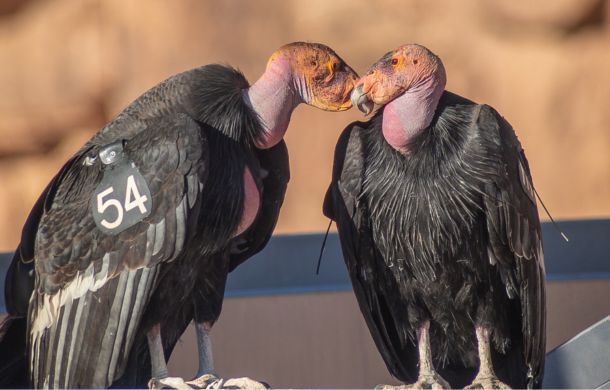The California condor is a majestic bird, although some may consider it ugly. The scientific name is Gymnogyps californianus. They are the largest North American land bird. An adult bird weighs around 25 pounds, and they have a wingspan measuring 9 to 10 feet. They are in the vulture family (OK, yeah, they’re not the prettiest birds). The species exists mainly on carrion.
Videos by InspireMore

In 1987, the California condor was declared extinct. All live birds were placed in captive breeding programs. There were no remaining live birds in the wild. Since then, the species has been raised in captivity and reintroduced to the wild beginning in 1992. They are still endangered, but nesting pairs live near the Navaho Bridge in Utah.

The Beginning Of A Love Story
All California condors have identification tags and are in a monitoring program. The Peregrine Fund is one of the agencies monitoring and tracking the birds near the Navaho Bridge. A love story, shared by KÜHL and The Peregrine Fund, began in February 2022 when two California condors were spotted over the Grand Canyon. A male (#619) and female (#775) engaged in flights together and, ultimately, the mating act. An egg was spotted in their cave on March 9.
From that egg hatched a baby condor (#1150). Baby condors grow from hatchling to fledging in six months. Both parents take an active role in feeding and training the young bird. On November 12, 2022, watchers saw #1150 take its first flight. The parents continue to nurture their fledgling for another year while it works to gain independence.

The family suffered a tragedy in March 2023. Highly Pathogenic Avian Influenza (HPAI) claimed the lives of 21 members of the flock, including the mother, #775. Single father #619 continued raising his young charge. The young bird learned well, and #1150 is now independent, seeking food and enjoying the skies. The youngster will begin searching for a mate when they are nearly six.
What The Future Holds For The California Condor
California condors mate for life. Although our widower remained single to finish raising his offspring, he is now seeking a new life partner. Enter female #741. The two seem well-suited to one another, but the pair faces additional challenges. Each of the birds in the monitoring program receives periodic health checks. During one check, lead poisoning was evident in #619. A short time later, #741 was also diagnosed with lead poisoning. After receiving treatment separately, both were returned to their natural habitat.

Monitoring agencies hope that the courtship will resume and provide an egg, but another concern is looming in the background. A second male suitor has entered the picture (#354) and is vying for the attention of #741. The new male is an established breeder. While #619 struggles to return to a mating relationship, #354 may disrupt his chances with #741. Monitors will continue watching to see how this plays out as the egg-laying season approaches.

Watching this potential romance play out in the wild is intense. California condors must continue to pair off and produce offspring. With only one new hatchling every two years per mating couple, re-establishing the species depends on there being romance in the air. If you enjoyed reading this love story, please share it to help raise awareness about the importance of re-establishing this once-extinct species.
John Sherman provided this story’s featured image.
Want to be happier in just 5 minutes a day? Sign up for Morning Smile and join over 455,000+ people who start each day with good news.


